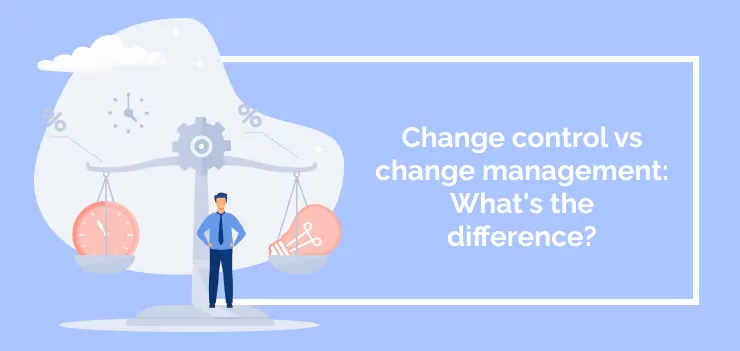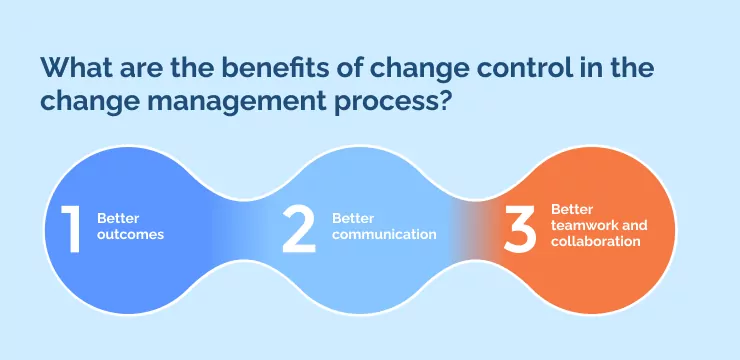
Imagine setting off on a road trip with a big group of friends. You already agreed on a destination together, and the driver has worked out the best possible route. Perhaps they’ve decided on some great tunes, an efficient route, and rest stops at appropriate locations.
But then someone pipes up from the back seat. They need vegan food. They need to use the bathroom. They want to stop at a nearby town to check out a museum. How do you listen to all these requests, and make sensible decisions about what to accept, what to decline, and how to compromise all around?
If you want to carefully balance everyone’s needs, welcome to the world of change control. Change control is a small (but very important) part of an overall change management process that deals with changes you might need to make to an initial plan.
This article will explain the connection between change control and the larger change management process. It will start by defining change control. We’ll go on to take a look at the benefits of effective change control. Then, we’ll briefly overview how to establish a good change control process.
Change control management is one complicated part of the complex change management business. All the same, it will help you to achieve your goals.
Change Control vs. Change Management
While change management covers every decision required for organizational change, change control is a process for requesting, approving, and implementing specific modifications to a change project. Change control involves the submission, evaluation, and implementation of small changes. Most change management projects will start by establishing clear baselines and targets. Change control respects those targets – while accepting that they might need to be revised.
Change control is also highly relevant in any kind of project management. When some part of a project needs to change, the change control process ensures that the processes happen promptly and effectively.
So, change control is just one small part of the change management process. It is easy to get confused between the terms. After all – in a different setting, “control” could be a synonym for “management”!
But let’s make this absolutely clear: change management and change control are not interchangeable terms.
What are the benefits of change control in the change management process?

Managers familiar with agile methodology of change will need no persuasion about change control: after all, they understand that iterative processes are essential for creating successful problems.
But even outside of agile projects, change control processes are designed to ensure that changes are made with care and consideration. By adhering to a change control process, organizations can reduce risk, maximize the value of the change, and ensure that everyone affected by the transition is informed.
Better outcomes
Change controls help to improve the outcomes of change projects.
As change practitioners know, the best-laid plans for a change might not work out quite as well as hoped. With the right methods, they can adapt the initial ideas so the project can still succeed. Change control ensures that a change management project can adapt thoughtfully and intelligently to emerging demands.
Very few change projects achieve the precise outcomes they set out to. Change controls make sure that they are, at the very least, effective and useful.
Better communication
In change management programs, communication can be very difficult. If the project change along the way, communication is even harder.
Change control improves communication. Change control means that all stakeholders are away from the changes being made, and they understand how it will affect them. This ensures that everyone can voice their concerns, and no one is left in the dark regarding their solution.
Better teamwork and collaboration
By providing clear guidelines and expectations for how changes should be managed, organizations can ensure that team members work together to reach their goals. However, change control may feel like “red tape.” The process means that people don’t have to compete over changes. Change leaders can give patient consideration to every change – wherever it comes from in the project team.
Change control is a great way to give employees direct input into change projects. As a 2022 Gartner article explains, this is an important facet of change management today.
How to implement change control process in a change management project
Change requests should be part of any change management strategy. At the outset, it may feel like a change control management plan is not worth it. But as you go through a change project, you might find that a clear set of change control tools make the difference between success and failure.
Start by establishing clear guidelines and procedures that will be followed for each proposed change. This should include change control templates, criteria for evaluating changes, and the project managers responsible for decision-making. Staff and leaders need to know that
Then, it can be valuable to create an easy-to-use system for recording and tracking changes. This will help ensure that all stakeholders are kept informed of the progress of changes and any impacts they may have. A clear change log will provide the change journey is monitored.
Finally, organizations should create a regular review process to evaluate the effectiveness of their change control system and make any adjustments as needed. This will help ensure that changes are being implemented efficiently and effectively. This level of oversight can help to iron out problems: for example, if staff feel that leaders are not taking their change requests seriously.
By following these steps, organizations can ensure a successful change control process to help manage their change management projects. By doing so, they can ensure that changes are made thoughtfully and responsibly while minimizing disruption and cost.
Change control vs. change management: Choosing what’s right for you
As explained in another article, the change management process contains different terminology. You’ve got to be familiar with all of those terms – otherwise, you just won’t be taken seriously.
So just in case you didn’t hear it, let’s say it again: change control is just one part of change management or successful project management. A good change control process ensures that only desirable modifications are made promptly, with the smallest disruption possible. An effective change control process is important for bigger projects.
Returning to the road trip we started out with. If you’ve ever spent time with other people, you’ll know that it’s important to listen to what everyone needs and adapt and change – where appropriate. Having an extra coffee break might be a perfect idea. However, if bad weather is coming or you have a time-sensitive booking, a delay of ten minutes could be a disaster for all project stakeholders.
A project or change management plan must be ready to adapt to changed circumstances. Change control offers one way to bring the benefits of a change project to the entire company.
WalkMe Team
WalkMe spearheaded the Digital Adoption Platform (DAP) for associations to use the maximum capacity of their advanced resources. Utilizing man-made consciousness, AI, and context-oriented direction, WalkMe adds a powerful UI layer to raise the computerized proficiency, everything being equal.



